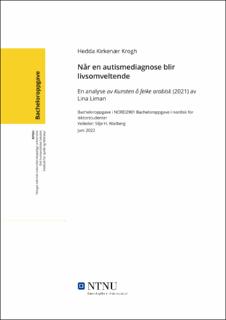| dc.contributor.advisor | Warberg, Silje Haugen | |
| dc.contributor.author | Krogh, Hedda Kirkenær | |
| dc.date.accessioned | 2022-07-16T17:20:16Z | |
| dc.date.available | 2022-07-16T17:20:16Z | |
| dc.date.issued | 2022 | |
| dc.identifier | no.ntnu:inspera:107174369:46762626 | |
| dc.identifier.uri | https://hdl.handle.net/11250/3006159 | |
| dc.description.abstract | Det er flere gutter enn jenter som utredes for autisme (NHI, 2021). Autisme, også kalt autismespekterdiagnose (ASD), har et bredt spekter av diagnosekriterier. Dette gjør diagnosen svært individuell. Hos noen kan diagnosetrekkene være såpass nyansert eller «skjult», at det kan være vanskelig å oppdage. Forfatter og journalist Lina Liman skriver om konsekvenser av å bli å diagnostisert med autisme (for) sent i sin selvbiografi Konsten att fejka arabiska (2017). Boken er skrevet kronologisk, med innslag av generell informasjon om autismediagnosen. Forfatteren forteller om sin vei til diagnosen, ved å se tilbake på egen oppvekst, og tiden som ung.
Denne analysen utforsker to ulike vinklinger som forfatteren vektlegger når hun forteller sin historie. Den ene vinklingen handler om hvordan forfatteren ser tilbake på oppveksten, fra et ståsted der hun allerede har fått diagnosen. Her overholder hun et diagnostisk blikk over ulike hendelser, for å rettferdiggjøre og begrunne hennes tidligere oppfatning av seg selv. Unge Lina skammet seg over å være «annerledes», men visste ikke at hun hadde ASD. Den andre vinklingen handler om kulturelle forventninger og stereotypier knyttet til autismen, og om hvordan forfatteren nyanserer disse på flere vis. Begge vinklingene knyttes opp mot problemstillingen «Hvilken funksjon får den sene autismediagnosen for Limans forståelse av sin egen identitet?», og drøftes i lys av en forståelse av autismediagnosen som identitetsskapende. Hva har ett ord, én diagnose, å si for et menneskets forståelse av seg selv? | |
| dc.description.abstract | There are fewer girls than boys who are examined for autism (NHI, 2021). Autism, also called "autism spectrum diagnosis" (ASD), has a wide range of diagnostic criteria. This makes the diagnosis very individual. For some people, the diagnostic features can be so nuanced or "hidden", that it can be difficult to detect. Author and journalist Lina Liman writes about the consequences of being diagnosed with autism (too) late in her autobiography Konsten att fejka arabiska (2017). The book is written chronologically, with elements of general information about the autism diagnosis. The author tells us about her path to the diagnosis, by looking back on her own upbringing, and her time as a young woman.
This analysis explores two different angles, that the author uses when she tells her story. One angle is about how the author looks back at her childhood, from a point of view where she has already been diagnosed. Here she uses a diagnostic view of various events, to justify her previous perception of herself. Young Lina was ashamed of being "different", but did not know she had ASD. The second angle is about cultural expectations and stereotypes associated with autism, and about how the author nuances these in several ways. Both angles are linked to this analysis' main issue: "What function does the late autism diagnosis have for Leman's understanding of his own identity?", and are discussed in light of an understanding of the autism diagnosis as identity-creating. What does one word, one diagnosis, have to say for a person's understanding of themselves? | |
| dc.language | nob | |
| dc.publisher | NTNU | |
| dc.title | Når en autismediagnose blir livsomveltende. En analyse av Kunsten å feike arabisk (2021) av Lina Liman. | |
| dc.type | Bachelor thesis | |
